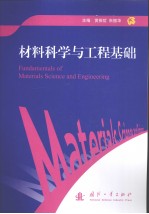图书介绍
材料科学与工程基础 英文pdf电子书版本下载

- 黄根哲,朱振华主编 著
- 出版社: 北京:国防工业出版社
- ISBN:9787118063493
- 出版时间:2010
- 标注页数:190页
- 文件大小:33MB
- 文件页数:201页
- 主题词:材料科学-高等学校-教材-英文
PDF下载
下载说明
材料科学与工程基础 英文PDF格式电子书版下载
下载的文件为RAR压缩包。需要使用解压软件进行解压得到PDF格式图书。建议使用BT下载工具Free Download Manager进行下载,简称FDM(免费,没有广告,支持多平台)。本站资源全部打包为BT种子。所以需要使用专业的BT下载软件进行下载。如 BitComet qBittorrent uTorrent等BT下载工具。迅雷目前由于本站不是热门资源。不推荐使用!后期资源热门了。安装了迅雷也可以迅雷进行下载!
(文件页数 要大于 标注页数,上中下等多册电子书除外)
注意:本站所有压缩包均有解压码: 点击下载压缩包解压工具
图书目录
Chapter 1 Crystalline Structures and Imperfections 1
1.1 Introduction 1
1.2 Classification of Materials 1
1.3 Structure of Atoms 3
1.4 Ideal Crystal,Space Lattice and Unit Cells 4
1.5 Crystal Structures and Bravais Lattices 5
1.6 Cubic Unit Cells 6
1.7 Basic Crystalline Structures in Metals 7
1.8 Packing Factor 9
1.9 Directions and Planes in Crystalline Structures 10
1.9.1 Directions in Cubic Unit Cell 10
1.9.2 Miller Indices for Crystallographic Planes in Cubic Unit Cell 11
1.9.3 Linear Density and Planar Density in Crystalline Structures 12
1.10 Crystalline Imperfections 13
1.10.1 Point Defects 14
1.10.2 Linear Defects(Dislocations) 15
1.10.3 P1anar Defects(Grain Boundaries) 16
1.10.4 Metallographic Examination 17
Problems 18
Chapter 2 Mechanical Properties of Metals 21
2.1 Introduction 21
2.2 Materials Relationship 21
2.3 Tensile Properties 22
2.3.1 Linear-Elastic Region and Elastic Constants 23
2.3.2 Yield Point 24
2.3.3 Ultimate Tensile Strength 25
2.3.4 Measures of Ductility(Elongation and Reduction of Area) 26
2.4 Mechanism of Elastic and Plastic Deformation 27
2.4.1 Metallic Bond 27
2.4.2 Mechanism of Elastic Deformation 28
2.4.3 Mechanism of Plastic Deformation 29
2.5 Other Mechanical Properties 32
2.5.1 Compressive Properties 32
2.5.2 Shear Properties 33
2.5.3 Impact Toughness 33
2.6 Work Hardening 34
2.6.1 Annealing of Work-hardened Materials 36
2.6.2 Hot Working and Cold Working 38
2.7 Hardness Test 39
2.7.1 Introduction 39
2.7.2 Brinell Hardness Test 39
2.7.3 Rockwell Hardness Test 40
2.7.4 Vickers Hardness Test 41
2.7.5 Scleroscope Hardness Tests 43
Problems 43
Chapter 3 Binary Phase Diagram 45
3.1 Introduction 45
3.2 Metallic Solid Solutions 45
3.2.1 Substitutional Solid Solutions 46
3.2.2 Interstitial Solid Solutions 47
3.3 Binary Isomorphous Alloy Systems 48
3.4 Construction of Phase Diagrams 49
3.4.1 Cooling Curve 50
3.4.2 Experimental Methods to Determine Phase Change Points 51
3.5 Solidification of Solid Solution Alloy 52
3.6 Binary Eutectic Alloy Systems 54
3.6.1 Slow Cooling of a Pb-Sn Alloy of Eutectic Composition 55
3.6.2 Slow Cooling of a 65% Pb-35% Sn Alloy 56
3.6.3 Slow Cooling of a 16% Pb-84% Sn Alloy 56
3.7 Binary Eutectoid Reactions 57
3.8 Binary Peritectic Alloy Systems 58
3.9 Phase Diagram with Intermediate Phases and Compounds 60
Problems 61
Chapter 4 Iron-Carbon Equilibrium Diagram 63
4.1 Introduction 63
4.2 Polymorphism and Allotropy 64
4.3 Fe-Fe3C Phase Diagram 65
4.3.1 Effect of Carbon on the Fe-Fe3C Phase Diagram 65
4.3.2 Solid Phases in the Fe-Fe3C Phase Diagram 65
4.3.3 Transformation Temperatures and Lines 67
4.4 Invariant Reactions in the Fe-Fe3C Phase Diagram 68
4.5 Slow Cooling of Plain carbon Steels 68
4.5.1 Eutectoid Plain-carbon Steel 68
4.5.2 Hypoeutectoid Plain-carbon Steels 70
4.5.3 Hypereutectoid Plain-carbon Steels 72
4.6 Cast Irons 73
4.6.1 General Properties 73
4.6.2 Types of Cast Irons 74
Problems 79
Chapter 5 Heat Treatment of Steels 82
5.1 Introduction 82
5.1.1 Heating Temperatures and Time 82
5.1.2 Cooling Rates 83
5.2 Critical Temperatures 83
5.3 Time-Temperature-Transformation(TTT Diagram) 85
5.4 Microstructures at Fast Cooling 89
5.4.1 Bainite 89
5.4.2 Martensite 91
5.5 General Purposes of Heat Treatment 95
5.6 Types of Heat Treatment 96
5.6.1 Annealing 96
5.6.2 Normalizing 98
5.6.3 Hardening and Tempering 99
5.7 Case Hardening 108
5.7.1 Atomic Diffusion in Solids 108
5.7.2 Case Hardening of Steel by Gas Carburizing 110
Problems 111
Chapter 6 Carbon and Alloy Steels 113
6.1 Introduction 113
6.2 Plain-carbon Steels 114
6.2.1 AISI-SAE Classification System for Plain-carbon Steels 114
6.2.2 Chinese National Standard Classification System for Plain-carbon Steels 114
6.2.3 Characteristics and Applications of Plain-carbon Steels 117
6.3 Low-alloy Steels 119
6.3.1 Effect of Alloying Elements in Steels 119
6.3.2 Effects of Alloying Elements on the Critical Temperature of the Fe-Fe3C Diagram 123
6.3.3 Classification of Low-alloy Steels 125
6.4 Tool Steels 129
6.4.1 Water-hardening Tool Steels(W-type) 130
6.4.2 Shock-resistant Tool Steels(S-type) 131
6.4.3 Cold-work(Oil-hardening)Tool Steels(O-type) 132
6.4.4 Cold-work(Medium-alloy,Air-hardening)Tool Steels(A-type) 133
6.4.5 Cold-work(high-carbon,high-chromium)Tool Steels(D-type) 135
6.4.6 Hot-work Tool Steels(H-type) 136
6.4.7 High-speed Tool Steels(T and M types) 139
6.5 Stainless Steels 141
6.5.1 Ferritic Stainless Steels 142
6.5.2 Martensitic Stainless Steels 143
6.5.3 Austenitic Stainless Steels 143
6.5.4 Duplex Stainless Steels 144
6.6 Chinese National Standard Classification System for Alloy Steels 145
6.6.1 Low Alloy High Strength Structural Steels 145
6.6.2 Alloy Carburizing Steels 146
6.6.3 Quenched&High Temperature Tempered Alloy Steels 147
6.6.4 Alloy Spring Steels 149
6.6.5 Gear Steels 150
6.6.6 Alloy Tool Steels 151
6.6.7 High Speed Tool Steels 152
6.6.8 Stainless Steels 152
Problems 154
Chapter 7 Nonferrous Metals and Its Alloys 156
7.1 Introduction 156
7.2 Aluminum and Its Alloys 156
7.2.1 A1uminum Alloy Temper and Designation System 157
7.2.2 Aluminum Alloys and Their Characteristics 161
7.2.3 Precipitation Strengthening of Aluminum Alloys 163
7.2.4 Precipitation Strengthening of an Al-4% Cu Alloy 166
7.2.5 Aluminum Casting Alloys 170
7.3 Copper and Its Alloys 171
7.3.1 Introduction 171
7.3.2 Copper Alloys 172
7.4 Titanium and Its Alloys 173
7.4.1 Introduction 173
7.4.2 Pure Titanium 174
7.4.3 Titanium Alloy Systems and Phase Diagrams 174
7.4.4 Classification of Titanium Alloys 176
7.5 Magnesium and Its Alloys 177
7.5.1 Introduction 177
7.5.2 Classification of Magnesium Alloys 177
7.5.3 Structure and Properties 178
Problems 178
References 180
APPENDIX Ⅰ Definitions 182
APPENDIX Ⅱ Conversion Factors to SI Units 190